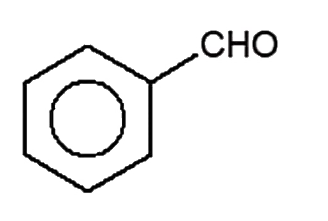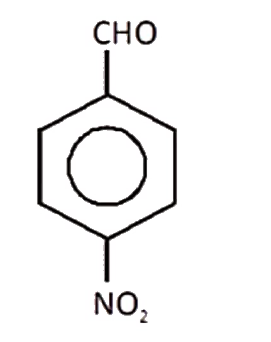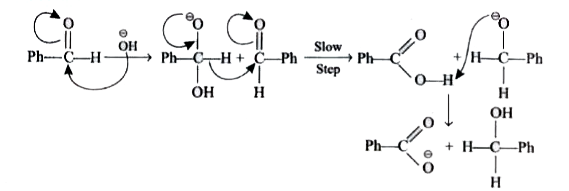Which of the following will show cannizzaro reaction :



All of these
The correct Answer is:D
To determine which of the given compounds will show the Cannizzaro reaction, we need to understand the conditions required for this reaction to occur.
1. Understanding the Cannizzaro Reaction:
- The Cannizzaro reaction occurs with aldehydes that do not have alpha hydrogens. In this reaction, one molecule of the aldehyde is oxidized to a carboxylic acid, while another molecule is reduced to an alcohol in the presence of a strong base (like NaOH).
2. Identifying the Aldehydes:
- We need to analyze the given compounds to check for the presence of alpha hydrogens. Aldehydes with no alpha hydrogen will undergo the Cannizzaro reaction.
3. Analyzing Each Compound:
- Compound 1: Benzaldehyde (C6H5CHO)
- Benzaldehyde has no alpha hydrogen (the carbon adjacent to the carbonyl carbon is not attached to any hydrogen). Therefore, it will undergo the Cannizzaro reaction.
- Compound 2: Formaldehyde (HCHO)
- Formaldehyde does not have any alpha hydrogen either. It will also undergo the Cannizzaro reaction.
- Compound 3: Glyoxal (O=CH-CHO)
- Glyoxal has two carbonyl groups but does not have any alpha hydrogen. Therefore, it will also undergo the Cannizzaro reaction.
4. Conclusion:
- Since all three compounds (Benzaldehyde, Formaldehyde, and Glyoxal) do not have alpha hydrogens, they will all show the Cannizzaro reaction.
Final Answer:
All of the compounds listed will show the Cannizzaro reaction.
- The Cannizzaro reaction occurs with aldehydes that do not have alpha hydrogens. In this reaction, one molecule of the aldehyde is oxidized to a carboxylic acid, while another molecule is reduced to an alcohol in the presence of a strong base (like NaOH).
- We need to analyze the given compounds to check for the presence of alpha hydrogens. Aldehydes with no alpha hydrogen will undergo the Cannizzaro reaction.
- Compound 1: Benzaldehyde (C6H5CHO)
- Benzaldehyde has no alpha hydrogen (the carbon adjacent to the carbonyl carbon is not attached to any hydrogen). Therefore, it will undergo the Cannizzaro reaction.
- Compound 2: Formaldehyde (HCHO)
- Formaldehyde does not have any alpha hydrogen either. It will also undergo the Cannizzaro reaction.
- Compound 3: Glyoxal (O=CH-CHO)
- Glyoxal has two carbonyl groups but does not have any alpha hydrogen. Therefore, it will also undergo the Cannizzaro reaction.
- Since all three compounds (Benzaldehyde, Formaldehyde, and Glyoxal) do not have alpha hydrogens, they will all show the Cannizzaro reaction.
All of the compounds listed will show the Cannizzaro reaction.
Similar Questions
Knowledge Check
- Question 1 - Select One or More
When an aldehyde with no α- hydrogen react with concentrated aqueous NaOH half the aldehyde is converted to carboxylic acid salt and other half is converted to an alcohol. In other words, half the reaction is oxidized and other half is reduced. This reaction is known as Cannizzaro reaction.

Mechanism:

Which of the following will not give Cannizzaro reaction?A B
B CCl−Cl∣C∣Cl−O∣∣C−HDH−O∣∣C−H
CCl−Cl∣C∣Cl−O∣∣C−HDH−O∣∣C−H - Question 2 - Select One
Which of the following aldehydes will show Cannizzaro reaction ?
AHCHOBC6H5CHOC(CH3)3CCHODAll of these. - Question 3 - Select One
Which of the following do not give Cannizzaro reaction?
ACl3C−O∣∣C−HBH−C∣∣O−HCPh−C∣∣O−HD
Cannizzaro's reaction
View SolutionWhich of the following will not undergo cannizzaro's reaction on heating with an alkali solution?
View SolutionWhich of the following cannot give Cannizzaro reaction?
View SolutionGive one example each of the following name reactions:
Cannizzaro's reactionView SolutionWhich of the following does not undergo Cannizzaro reaction?
View Solution

